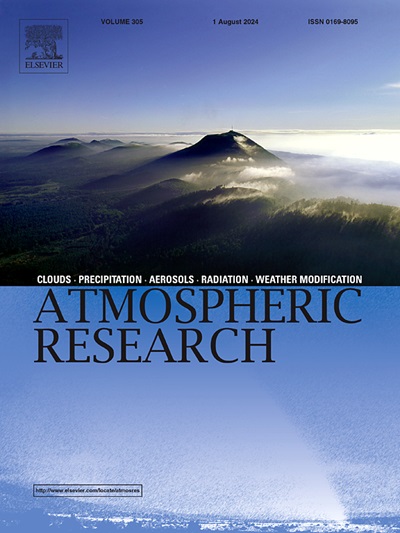Extreme wind speed estimation in thunderstorm gales utilizing dual-polarization weather radar hydrometeor classification products
IF 4.5
2区 地球科学
Q1 METEOROLOGY & ATMOSPHERIC SCIENCES
引用次数: 0
Abstract
Severe thunderstorm gales are the predominant meteorological phenomena associated with convective storms. Accurately estimating the extreme wind speed of thunderstorm gales (ESTG) is crucial for both forecasting services and disaster investigations related to severe convective weather. This paper proposes a method for estimating the ESTG based on dual-polarization weather radar hydrometeors classification products (EESonHC). This method utilizes changes in hydrometeors, combines these changes with the atmospheric vertical momentum equation, and estimates the ESTG by approximating the average vertical acceleration of storm cells. Experimental tests were conducted using cases of thunderstorm gales in both strong and weak wind shear environments, demonstrating that this estimation method achieves an accuracy rate as high as 75 % for extreme thunderstorm gales exceeding 25 m/s, with an average error in estimated wind speed of approximately 0.5 m/s. The primary issues include: 1. When multiple storm cells are in close vicinity, accurately isolating the vertical motion acceleration pairs for each individual cell becomes challenging, thereby complicating wind speed estimation; 2. Overestimating ice-phase hydrometeors in HCL could lead to underestimating wind speed or make it impossible to estimate accurately.
利用双极化气象雷达水流星分类产品估算雷暴大风极端风速
强雷暴风是与对流风暴有关的主要气象现象。准确估计雷暴风的极端风速对于强对流天气的预报服务和灾害调查至关重要。提出了一种基于双极化气象雷达水文分类产品(EESonHC)的ESTG估计方法。该方法利用水成物的变化,将这些变化与大气垂直动量方程相结合,通过近似风暴单体的平均垂直加速度来估计ESTG。在强、弱风切变环境下对雷暴大风进行了实验测试,结果表明,该方法对超过25 m/s的极端雷暴大风的估计准确率高达75%,估计风速的平均误差约为0.5 m/s。主要问题包括:1。当多个风暴单体靠近时,准确分离每个单体的垂直运动加速度对变得具有挑战性,从而使风速估计复杂化;2. 过高估计HCL中冰相水成物可能导致低估风速或使其无法准确估计。
本文章由计算机程序翻译,如有差异,请以英文原文为准。
求助全文
约1分钟内获得全文
求助全文
来源期刊

Atmospheric Research
地学-气象与大气科学
CiteScore
9.40
自引率
10.90%
发文量
460
审稿时长
47 days
期刊介绍:
The journal publishes scientific papers (research papers, review articles, letters and notes) dealing with the part of the atmosphere where meteorological events occur. Attention is given to all processes extending from the earth surface to the tropopause, but special emphasis continues to be devoted to the physics of clouds, mesoscale meteorology and air pollution, i.e. atmospheric aerosols; microphysical processes; cloud dynamics and thermodynamics; numerical simulation, climatology, climate change and weather modification.
 求助内容:
求助内容: 应助结果提醒方式:
应助结果提醒方式:


